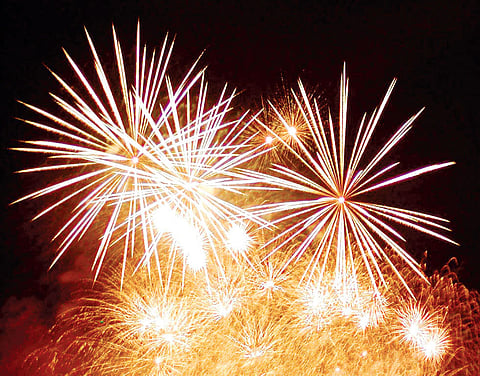

We are all aware that Deepavali or Diwali as it is called north of the Vindhyas marks the vadha or killing of Narakasura by Sri Krishna. We Hindus celebrate this day with fireworks and sweets. There is indeed no other festival in Hinduism which commands such enthusiasm and gaiety across the length and breadth of the country as Deepavali.
In fact the Asura himself prayed to Lord Krishna that the occasion should be replete with good cheer and unalloyed happiness, and his mother Bhoodevi endorsed the prayer. “Let me suffer for my wrongdoings but let everyone be happy and prosperous,” was the prayer of the demon Narakasura.
He has thereby given us all an example to follow. Can we not think of adopting this approach and carry goodwill to others, despite our own sufferings?
Holy Ganga
On the day of Deepavali we believe that the holy Ganga comes through our taps or the well in our backyard) and it is Gangajal that we use for our mandatory oil-bath. Hindus get up before sunrise for this ritual oil-bath known as Ganga Snanam. The bath involves extensive massaging of the body with warm til oil containing pepper corns and betel leaves.
After the Ganga snanam a home-made semi-solid mixture known as Deepavali Lehiyam, which has excellent medicinal value, is consumed. The lehiyam prepares one’s stomach and liver for the onslaught of sweets and other rich foods that are eaten through the day and the week.
New clothes are typically worn as part of the celebration. In some homes the first thing done after wearing the new dresses is a visit to the nearby temple as a family, all together a great practice indeed.
Fireworks are an integral part of Deepavali, and in several parts of India like Mumbai fireworks start a week before and go on for two weeks after Diwali.
Three more legends
In addition to the lore of Narakasura, there are at least 3 more legends relating to this festival. In UP, Bihar, Haryana and Punjab, Diwali is celebrated as the Day of Rama’s triumphant return to Ayodhya. In rural areas of northern India Diwali signifies the Harvest Festival. And in the entire north and west Diwali is the day for Lakshmi Puja or the worship of the Goddess of Wealth and Prosperity.
*Whatever be the legend, the Hindus and all other Indians from Kanyakumari to Kashmir pray for everyone’s happiness, disease-free life and peaceful living. The only thought in the breast of every Indian on Diwali day is for our punya bhoomi and for the happiness of its people. Deepavali or Diwali commemorates the renewal of life and the lifting of darkness. *
A wistful thought: why don’t all Hindus take a vow on this glorious day to aspire for spiritual progress? Why don’t we get into the spiritual ethos of Deepavali?
As Hindus we believe in the philosophy of the Atma or the Atman: something far beyond and higher than the physical body and mind, something pure, infinite and eternal. Let us spend a few minutes on this Deepavali Day thinking about our ‘atma’ and how we can edify our habits, our lifestyles and indeed our lives, to reach and be one with the atman.
Bhagavad Gita
Which brings me to the teachings of Bhagavad Gita, one of the greatest Hindu scriptures. Gita is part of the Hindu epic Mahabharata. It is an eighteen-chapter discourse with 700+ verses, in the form of a conversation between Lord Krishna and Arjuna on the battlefield of Kurukshetra. In Gita, Sri Krishna through Arjuna reveals profound, sublime and soul-stirring truths and expounds the rare secrets of Bhakti Yoga, Karma Yoga, Gnana yoga and Vedanta. Gita has practical answers for all the problems that we face today as individuals, and even the issues that beset our nation.
Gita is not just a book of verses but a treasure. It should be read, re-read and read over and over in a spirit of pure Bhakti. The seeker. who sits at the feet of a Guru to get in-depth knowledge of the Gita is certain to realise that it is not a mere exposition, but a divine experience.
Adi SankaRa & Ramanujacharya
We have Adi Sankara and Ramanuja, proponents of two powerful school of thoughts, extolling this great scripture. Adi Sankaracharya in his ‘Bhaja Govindam’ says: “Bhagavad Gita kinchitadheeta one should read at least a portion of the Gita every day.” Sri Ramanujacharya of Vaishnava sampradaya extolled the great scripture.
Ramanuja’s Gita Bhashya is one of the most popular commentaries on the Bhagavad Gita.
In the recent times too, we have wonderful commentaries by several holy men: Swami Chinmayananda, Swami Dayananda Saraswati, and Pujya Sri Jayendra Saraswati Swamigal to name a few. So can we make a solemn resolution to ourselves on the Deepavali day this year, to start reading some slokas every morning from the Bhagavad Gita? From reading the concepts to practising them is but a short step: and when you do that you are sure to witness a welcome change in your life, a move towards realising the atman. Happy Deepavali. Sarve janaaha sukhino Bhavantu!
Sarma Sastrigal is an author and performing priest. He can be reached at sarmasasthrigal@gmail.com